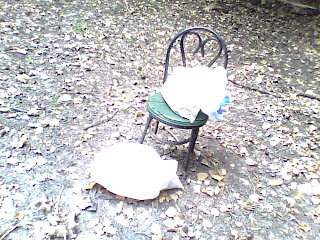How I felt about the plot study project:
Trekking over to my plot each week was not necessarily something I looked forward to after a hard volleyball practice or writing an American history paper, but every time I ventured over to my plot I discovered something new and intriguing that I had not previously expected to be a part of my plot. "How Great Thou Art" was always running through my head as I examined the fallen leaves, delicate spider webs, fishes' dainty air bubbles, and even the quick lope of a deer after I had surprised it. I don't consider myself a nature girl, but rather a city girl. However, this project allowed me to access that side of myself, if only for a few brief moments each week. Were the bug bites, mudstained sweatpants, and scratched arms worth these peaceful times? Yes. Although I admit to being skeptical of the project at times, at the very least it's an experience that will make for interesting conversations around the dinner table.
5 things I learned from the plot study:
1) I learned about purple loosestrife and its negative effect on communities, but I also learned to identify weeds such as purple aster, which benefit ecosystems as insects pollinate them.
2) I learned that pond water, soil, leaves, and grass are much more complex than they are often credited for; God created them to serve their purpose in an ecosystem perfectly. I was astounded by the beauty of some of the pictures captured with the microscope camera.
3) I learned that littering is a widespread problem that can affect the environment even deep within the woods. It's not confined to the roadside, and it's an issue that should be addressed because such trash as the plastic tarps and bags I found can damage habitats and even kill organisms when they become embedded in the muck or are handled by unsuspecting animals.
4) Both biotic and abiotic factors can drastically affect an ecosystem. I saw the abiotic factor of precipitation level bring a creek in a ditch on my plot from thin and shallow to nonexistent to wide and deep throughout the early to mid-fall.
5) The inner workings on my plot were much more complicated than it first appeared. Between the competition, predation, mutualism, commensalism, and parasitism on my plot, there were a ton of interactions going on in my plot than I would have ever imagined just walking around in it. Food chains and webs built on the concept of trophic levels would've gone right over my head if I had gone traipsing around my plot before this class, but after our class discussions a small plot of woods and pond surface turned into a complex network of survival.
What I will do with new knowledge about my plot and ecology:
With new insights and information gained through my plot study, I will have to make a few notable changes in lifestyle. Regularly recycling and picking up and disposing of litter are two habits of action that I can build. Also, I have a greater appreciation for the complexity and beauty of God's creation and His established order in the natural world, including levels of organization, trophic levels within food chains and webs, the details within each tiny organism as viewed by a microscope, the hundreds of factors that work together to make conditions balanced in an ecosystem, the different interactions between species, and even the sheer number of species that God made and put on the Earth, from the tiniest insects and phytoplankton to fascinating fungi to the hawk and deer. The adaptations that organisms make to survive changes in weather (observed throughout these two months) and the organisms around them is incredible, and through watching other organisms cope with these things I see how humans must cope and change. I don't plan on having a career in biology, but the fresh viewpoint the project gave me is something I can and will use.


























